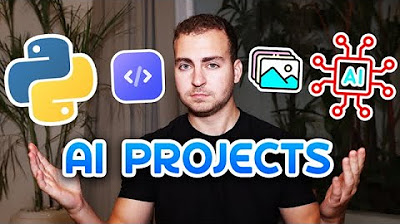The Secrets Behind Voice Cloning & AI Covers
Summary
TLDRThis video provides an overview of the current state of AI voice generation technologies. It explains the two main types: text-to-speech, which converts text into audio, and voice-to-voice conversion, which clones voices. It then covers the popular AI models used for each type, like Tacotron 2 and Tortoise for text-to-speech, and so-vits-svc and RVC for voice cloning. It discusses popular services like UberDuck, FakeYou, and ElevenLabs that leverage these models, comparing their capabilities, limitations and use cases. Finally, it imagines creative applications, like translating content while retaining the original creator's voice or utilizing multiple models together to achieve high quality and convenience.
Takeaways
- 😃Two main types of voice cloning: text-to-speech synthesis and voice-to-voice conversion
- 👂Popular text-to-speech backbones: Tacotron 2 and Tortoise TTS
- 🎤Popular voice-to-voice conversion options: so-vits-svc and RVC
- 🔊HiFiGAN is a commonly used vocoder for generating audio waveforms
- 🚀Services: UberDuck, FakeYou, ElevenLabs offer text-to-speech and cloning
- 🤖ElevenLabs offers easy 1 minute voice cloning with decent quality
- ⚙️Tortoise + RVC offers high quality custom text-to-speech pipelines
- 🎙Combining Tortoise and RVC enables fully AI generated narration
- 💰Brilliant provides structured, interactive STEM learning content
- 👍Video creator open to collaborating on custom voice pipelines
Q & A
What are the two main types of voice cloning technologies discussed?
-The two main types discussed are pure text-to-speech synthesis and voice-to-voice conversion.
What is the difference between Tacotron 2 and Tortoise TTS?
-Tacotron 2 is faster but lower quality, while Tortoise TTS is slower but higher quality. Tortoise also needs less training data and time.
What vocoder is commonly used with these voice synthesis technologies?
-HiFiGAN is a commonly used vocoder because it can generate high quality and natural sounding speech quickly.
What are so-vits-svc and RVC?
-So-vits-svc and RVC are two popular voice-to-voice conversion technologies, with RVC being a more recent advancement.
What services offer pre-trained voice models?
-Services like Uberduck, FakeYou, and ElevenLabs offer access to pre-trained voice models, both text-to-speech and voice conversion.
What tools allow you to train custom voice models?
-There are open source tools like Tortoise TTS GUI and RVC UI that allow training custom voice models locally.
What innovation combines Tortoise TTS and RVC?
-Using Tortoise TTS output as reference audio input for RVC allows high quality text-to-speech without need for reference audio.
How was the narration in this video generated?
-The narration was generated using Tortoise TTS trained on the narrator's voice, piped into RVC for smoothing and quality enhancement.
What are some applications of this technology?
-Applications include translating content while keeping original creator's voice, lip syncing, cloning voice actors, and more.
What sponsorship was included?
-Brilliant.org sponsored the video, offering STEM courses like AI and coding in an intuitive format.
Outlines

Dieser Bereich ist nur für Premium-Benutzer verfügbar. Bitte führen Sie ein Upgrade durch, um auf diesen Abschnitt zuzugreifen.
Upgrade durchführenMindmap

Dieser Bereich ist nur für Premium-Benutzer verfügbar. Bitte führen Sie ein Upgrade durch, um auf diesen Abschnitt zuzugreifen.
Upgrade durchführenKeywords

Dieser Bereich ist nur für Premium-Benutzer verfügbar. Bitte führen Sie ein Upgrade durch, um auf diesen Abschnitt zuzugreifen.
Upgrade durchführenHighlights

Dieser Bereich ist nur für Premium-Benutzer verfügbar. Bitte führen Sie ein Upgrade durch, um auf diesen Abschnitt zuzugreifen.
Upgrade durchführenTranscripts

Dieser Bereich ist nur für Premium-Benutzer verfügbar. Bitte führen Sie ein Upgrade durch, um auf diesen Abschnitt zuzugreifen.
Upgrade durchführenWeitere ähnliche Videos ansehen
5.0 / 5 (0 votes)






